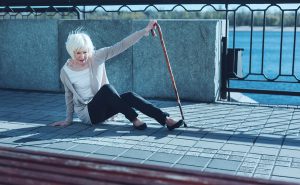Providing Evidence for Your Slip and Fall Case
 Michael Babboni
Premises Liability
Slip and fall cases, while common, may be incredibly hard to prove if you don't collect the right evidence to prove your claim. The evidence you will need to collect for your claim will depend on the kind of accident. Slip and fall cases can be broken down into several different categories as outlined below:
Michael Babboni
Premises Liability
Slip and fall cases, while common, may be incredibly hard to prove if you don't collect the right evidence to prove your claim. The evidence you will need to collect for your claim will depend on the kind of accident. Slip and fall cases can be broken down into several different categories as outlined below:• Slip on a foreign substance; i.e., water, ice, oil, etc.
• Fall on stairs
• Trips and slips on floors and thresholds
Slipping on Substances
When you collect evidence, you need to find ways to prove the conditions at the time of the accident. Pictures are always a great form of evidence if it is possible to do so. If you can't take photos of how the area was when the accident occurred, you will find that it is going to be much harder to prove your case. The burden of proof falls on you.
You need to be able to show proof of whatever substance you slipped on, the area in which the accident occurred, and any evidence that can show proof of negligence of the owners.
Slip and Fall on Stairs
When you fall or become injured on stairs, you need to focus more on the design of the stairs and why the accident happened in the first place. Were there no handrails available? Maybe there was a handrail, but it was broken. Check the height of the stairs and if your feet can properly rest on the stairs as well. Are they in any kind of disarray? Worn or broken?
Again, pictures will help prove the current condition of the stairs as they were during your fall. Your personal injury attorney may even go as far as hiring an expert to inspect the stairs themselves and report back with any problems or issues that don't fall in line with applicable building codes.
Your lawyer may also request that the owner provide proof of maintenance records and their repair policies to further cover all the bases.
The same information can also apply to a slip or fall on a threshold. Were there signs posted warning people of the height of the step or threshold? Or a warning stating there was one ahead?
What You Must Prove
For a slip and fall case, your evidence needs to prove three things. These three things include liability, negligence, and responsibility and fault.
Was the property owner negligent when performing their duty of care? Was that duty breached by the defendant which ultimately caused harm to the plaintiff?
Was negligence a major contributing factor in the injuries sustained by the plaintiff?
There are different levels regarding an owner's duty of care, and it is up to you as the plaintiff to prove that their negligence was the reason you slipped, fell, or tripped. You must prove that the owner failed to act reasonably and take the steps needed to prevent an injury from happening in the first place.
Slip and fall cases can definitely prove to be complicated, so it may be in your best interest to hire a personal injury attorney to make sure you have provided all the evidence you need to prove negligence and win your case.
